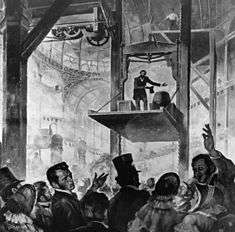New York Crystal Palace
Coordinates: 40°45′13″N 73°59′02″W / 40.75361°N 73.98389°W

New York Crystal Palace was an exhibition building constructed for the Exhibition of the Industry of All Nations in New York City in 1853, which was under the presidency of the mayor Jacob Aaron Westervelt. The building stood in Reservoir Square.
New York City's 1853 Exhibition was held on a site behind the Croton Distributing Reservoir, between Fifth and Sixth Avenues on 42nd Street, in what is today Bryant Park in the borough of Manhattan. The New York Crystal Palace was designed by Georg Carstensen and German architect Charles Gildemeister, and was directly inspired by The Crystal Palace built in London's Hyde Park to house The Great Exhibition of 1851. The New York Crystal Palace had the shape of a Greek cross, and was crowned by a dome 100 feet in diameter. Like the Crystal Palace of London, it was constructed from iron and glass. Construction was handled by engineer Christian Edward Detmold.[1] Horatio Allen was the consulting engineer, and Edward Hurry the consulting architect.[2]
President Franklin Pierce spoke at the dedication on July 14, 1853. Theodore Sedgwick was the first president of the Crystal Palace Association. After a year, he was succeeded by Phineas T. Barnum who put together a reinauguration in May 1854 when Henry Ward Beecher and Elihu Burritt were the featured orators. This revived interest in the Palace, but by the end of 1856 it was a dead property.[2]
The adjoining Latting Observatory, a wooden tower 315 feet (96 m) high, allowed visitors to see into Queens, Staten Island and New Jersey. The tower, taller than the spire of Trinity Church at 290 feet (88 m), was the tallest structure in New York City from the time it was constructed in 1853 until it burned down in 1856.[3]

The New York Crystal Palace itself was destroyed by fire on October 5, 1858. When it burned, the fair of the American Institute was being held there. The fire began in a lumber room on the side adjacent to 42nd Street. Within fifteen minutes its dome fell and in twenty-five minutes the entire structure had burned to the ground. No lives were lost but the loss of property amounted to more than $350,000. This included the building, valued at $125,000, and exhibits and valuable statuary remaining from the World's Fair.[4]
Elisha Otis demonstrated the safety elevator, which prevented the fall of the cab if the cable broke, at the Crystal Palace in 1854 in a death-defying, dramatic presentation.[5] That year another building directly inspired by London's Crystal Palace, the Glaspalast in Munich, was inaugurated.
References
- Notes
- ↑
 Wilson, James Grant; Fiske, John, eds. (1900). "Detmold, William Ludwig". Appletons' Cyclopædia of American Biography. New York: D. Appleton.
Wilson, James Grant; Fiske, John, eds. (1900). "Detmold, William Ludwig". Appletons' Cyclopædia of American Biography. New York: D. Appleton. - 1 2 New-York Crystal Palace.; A Famous Enterprise Recalled by the Death of its Chief Promoter, from The New York Times, 5 July 1887.
- ↑ Pollak, Michael. "F.Y.I.: Over the Bounding Pond", The New York Times, August 28, 2005. Accessed May 18, 2009.
- ↑ New York Times, Other Burned Theatres, December 7, 1876, Page 10.
- ↑ The Elevator Museum, timeline; "Skyscrapers" Magical Hystory Tour: The Origins of the Commonplace & Curious in America (September 1, 2010).
- Bibliography
- Carstensen & Gildemeister, New York Crystal Palace: illustrated description of the building by Geo. Carstensen & Chs. Gildemeister, architects of the building ; with an oil-color exterior view, and six large plates containing plans, elevations, sections, and details, from the working drawings of the architects (New York: Riker, Thorne & co., 1854)
- CUNY Graduate Center, "Crystal Palace/42 Street/1853-54" ; Catalogue by Linda Hyman of an exhibition mounted at the Graduate Center Mall from October 7 to 26, 1974. [36] pp, 22 b/w illustrations, bibliographic note. (New York: CUNY Graduate Center, 1974)
External links
- "1853-54 New York: Exhibition of the Industry of All Nations". World's Fair Overview 1851-1970. University of Maryland Libraries. Archived from the original on 22 August 2012. Retrieved 23 August 2013.
- History of Bryant Park
- The Great Crystal Palace Fire of 1858 from the Museum of the City of New York Collections blog
- The New York Crystal Palace Records at the New York Historical Society